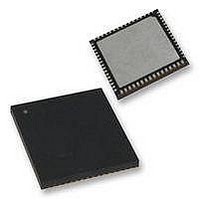PIC24FJ64GA106-I/MR Microchip Technology, PIC24FJ64GA106-I/MR Datasheet - Page 127

PIC24FJ64GA106-I/MR
Manufacturer Part Number
PIC24FJ64GA106-I/MR
Description
16-bit, 16 MIPS, 64KB Flash, 16Kb RAM, 84 I/O, NanoWatt 64 QFN 9x9x0.9mm TUBE
Manufacturer
Microchip Technology
Series
PIC® 24Fr
Datasheet
1.PIC24FJ128GA106-IPT.pdf
(330 pages)
Specifications of PIC24FJ64GA106-I/MR
Core Processor
PIC
Core Size
16-Bit
Speed
32MHz
Connectivity
I²C, IrDA, LIN, SPI, UART/USART
Peripherals
Brown-out Detect/Reset, LVD, POR, PWM, WDT
Number Of I /o
53
Program Memory Size
64KB (22K x 24)
Program Memory Type
FLASH
Ram Size
16K x 8
Voltage - Supply (vcc/vdd)
2 V ~ 3.6 V
Data Converters
A/D 16x10b
Oscillator Type
Internal
Operating Temperature
-40°C ~ 85°C
Package / Case
64-VFQFN Exposed Pad
Processor Series
PIC24FJ256GA110
Core
PIC
Data Bus Width
16 bit
Data Ram Size
16 KB
Interface Type
UART, I2C, SPI
Maximum Clock Frequency
8 MHz
Number Of Timers
5
Operating Supply Voltage
3.6 V
Maximum Operating Temperature
- 40 C to + 85 C
Mounting Style
SMD/SMT
Lead Free Status / RoHS Status
Lead free / RoHS Compliant
Eeprom Size
-
Lead Free Status / Rohs Status
Details
- Current page: 127 of 330
- Download datasheet (3Mb)
10.0
All of the device pins (except V
OSCI/CLKI) are shared between the peripherals and
the parallel I/O ports. All I/O input ports feature Schmitt
Trigger inputs for improved noise immunity.
10.1
A parallel I/O port that shares a pin with a peripheral is,
in general, subservient to the peripheral. The periph-
eral’s output buffer data and control signals are
provided to a pair of multiplexers. The multiplexers
select whether the peripheral or the associated port
has ownership of the output data and control signals of
the I/O pin. The logic also prevents “loop through”, in
which a port’s digital output can drive the input of a
peripheral that shares the same pin.
how ports are shared with other peripherals and the
associated I/O pin to which they are connected.
FIGURE 10-1:
2010 Microchip Technology Inc.
Note:
I/O PORTS
Parallel I/O (PIO) Ports
Section 12. “I/O Ports with Peripheral
This data sheet summarizes the features of
this group of PIC24F devices. It is not
intended to be a comprehensive reference
source. For more information, refer to the
“PIC24F
Pin Select (PPS)” (DS39711).
Read TRIS
Data Bus
WR TRIS
WR LAT +
WR PORT
Read LAT
Read PORT
Family
BLOCK DIAGRAM OF A TYPICAL SHARED PORT STRUCTURE
Peripheral Input Data
Peripheral Module Enable
Peripheral Output Enable
Peripheral Output Data
Peripheral Module
PIO Module
Reference
TRIS Latch
DD
Data Latch
D
D
CK
CK
, V
Figure 10-1
SS
Q
Q
, MCLR and
Manual”,
PIC24FJ256GA110 FAMILY
shows
Output Multiplexers
When a peripheral is enabled and the peripheral is
actively driving an associated pin, the use of the pin as
a general purpose output pin is disabled. The I/O pin
may be read, but the output driver for the parallel port
bit will be disabled. If a peripheral is enabled, but the
peripheral is not actively driving a pin, that pin may be
driven by a port.
All port pins have three registers directly associated
with their operation as digital I/O. The Data Direction
register (TRIS) determines whether the pin is an input
or an output. If the data direction bit is a ‘1’, then the pin
is an input. All port pins are defined as inputs after a
Reset. Reads from the Output Latch register (LAT),
read the latch. Writes to the latch, write the latch.
Reads from the port (PORT), read the port pins, while
writes to the port pins, write the latch.
Any bit and its associated data and control registers
that are not valid for a particular device will be
disabled. That means the corresponding LAT and
TRIS registers and the port pin will read as zeros.
When a pin is shared with another peripheral or func-
tion that is defined as an input only, it is regarded as a
dedicated port because there is no other competing
source of outputs.
1
0
1
0
Output Enable
Output Data
Input Data
I/O
I/O Pin
DS39905E-page 127
Related parts for PIC24FJ64GA106-I/MR
Image
Part Number
Description
Manufacturer
Datasheet
Request
R

Part Number:
Description:
Manufacturer:
Microchip Technology Inc.
Datasheet:

Part Number:
Description:
Manufacturer:
Microchip Technology Inc.
Datasheet:

Part Number:
Description:
Manufacturer:
Microchip Technology Inc.
Datasheet:

Part Number:
Description:
Manufacturer:
Microchip Technology Inc.
Datasheet:

Part Number:
Description:
Manufacturer:
Microchip Technology Inc.
Datasheet:

Part Number:
Description:
Manufacturer:
Microchip Technology Inc.
Datasheet:

Part Number:
Description:
Manufacturer:
Microchip Technology Inc.
Datasheet:

Part Number:
Description:
Manufacturer:
Microchip Technology Inc.
Datasheet:










